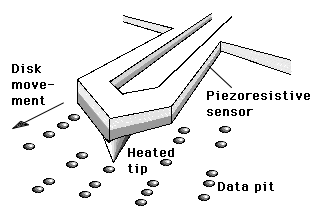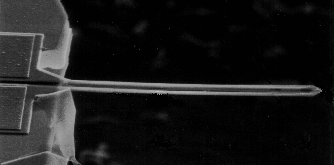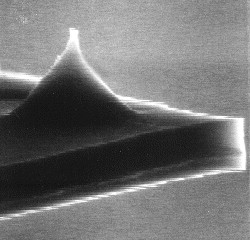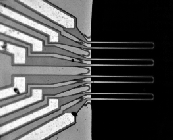
*IBM Almaden Research Center, San Jose, California 95120
AFM Thermo-mechanical Data Storage is a data storage
scheme invented at IBM in which tiny pits on a plastic disk represent
digital data. ("AFM" stands for "Atomic Force Microscope.")
At present, bit densities of 25 gigabits per square inch are achievable.
A single-crystal silicon micromachined cantilever with a sharp tip can be
used to write and read such data 0's and 1's. For reading, we are
fabricating such a cantilever with an integrated deflection sensor.
For writing, we are incorporating a heating element into the
cantilever.

As can be seen from the diagram above, the tip of a cantilever is
positioned over a spinning polycarbonate disk which has a melting point
of about 120 degrees Celsius. When the tip is heated (as has been
demonstrated with
a laser pulse), it melts the polycarbonate upon contact, creating a tiny
indentation. Heating can also be achieved with an integrated heater,
eliminating the need for an external laser. The tip of the cantilever
is kept in contact with the spinning disk by means of
a very small loading force applied to the base of the cantilever.
At a sufficiently small loading force, no wear occurs on
either the tip or the disk. The indentations on the polycarbonate disk
can be used to represent encoded digital data.
Bit reading depends on the piezoresistivity of the silicon
cantilever. Heavily doped silicon exhibits piezoresistivity in that
its resistance changes slightly under stress. Therefore a heavily doped
cantilever can be used to sense indentations on a disk: whenever the
tip rides over an indentation, the cantilever flexes one way or the other.
The stress in the cantilever varies accordingly, and so does the
resistance. These slight changes in resistance can be converted to
voltage signals, amplified and processed to regenerate digital data.
This is a top-view photo of a fabricated cantilever. The cantilever
is made of single-crystal silicon and is about 70 microns in length.
It has an integrated piezoresistive deflection sensor.
This is an SEM image of a similar, but longer, cantilever:
The following is an SEM close-up image of the cantilever tip. The thickness
of the cantilever is about 1 micron, and the tip is about 2 microns tall.
Active research is continuing in AFM thermo-mechanical data storage.
Collaboration on this program between Stanford and IBM is a good
example of a partnership between academia and industry. Under
this arrangement, Stanford's sophisticated semiconductor fabrication
facilities (such as those in
CIS, the Center for Integrated Systems) can be used to make
advanced components for exploratory studies at IBM.
It is possible that very high bit densities at a low cost per bit can
be achieved with AFM thermo-mechanical data storage. Furthermore, the
use of cantilever arrays (see photo below) could directly
improve the speed of data reading
and writing through parallel operation. Finally, the basic technology
behind micromachined cantilevers with integrated tips can be applied
to other high-density data storage schemes as well.
Click
here to see a listing of recent literature on
AFM thermomechanical data storage or to download an animated video
clip on the subject (courtesy of
IBM Almaden Research Center).
For further information, please email the following people:
(Updated December 1995)
DATA WRITING
DATA READING



Project Outlook

Your comments are very welcome.
Ben Chui at chui@leland.stanford.edu;
Prof. Thomas Kenny at kenny@sunrise.stanford.edu;
H. Jonathan Mamin at mamin@almaden.ibm.com.;
Bruce Terris at terris@almaden.ibm.com.;
Robert Ried at ried@almaden.ibm.com.;
Daniel Rugar at rugar@almaden.ibm.com.